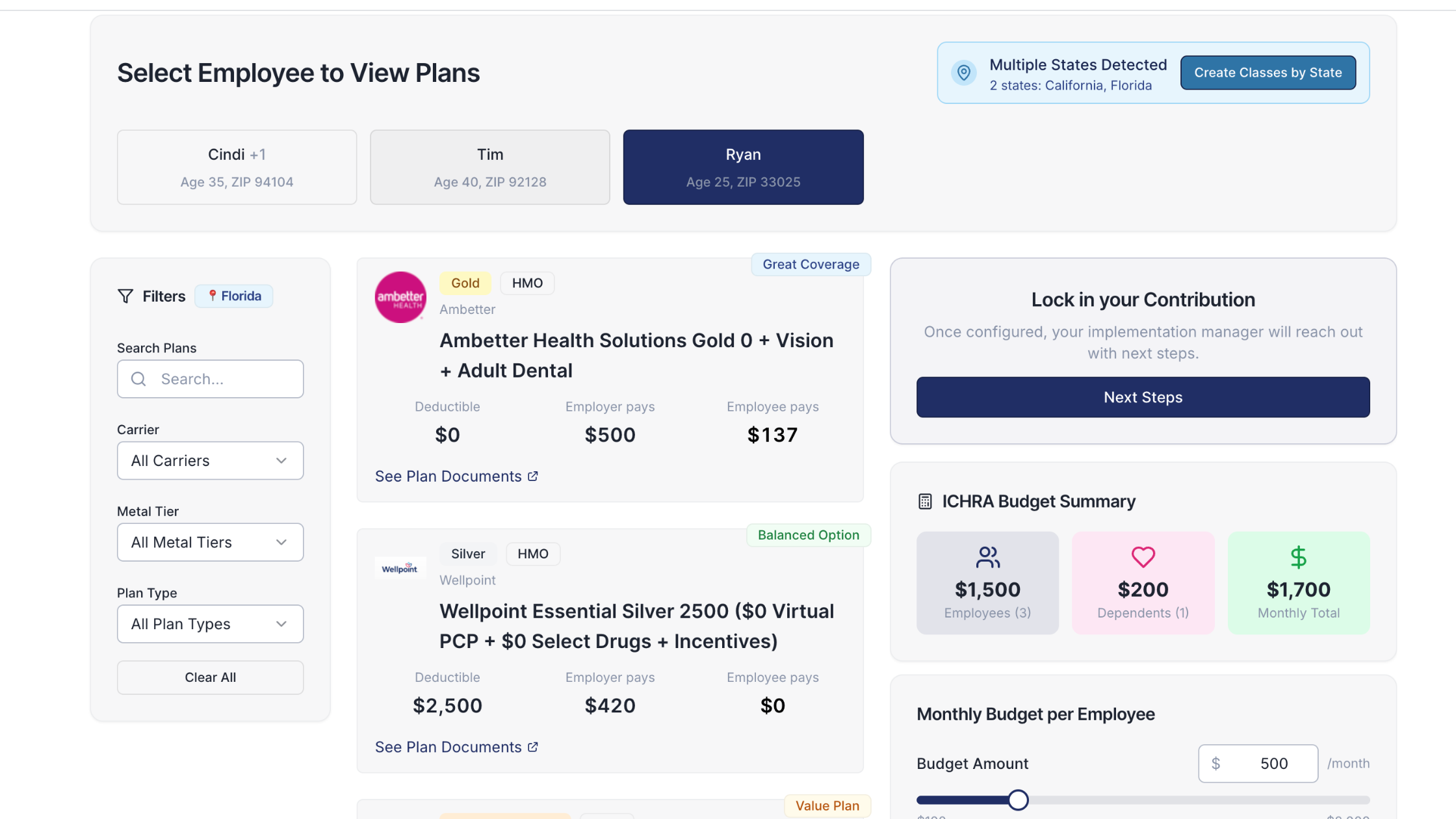What Is a Copayment? Understanding Fixed Costs in Health Insurance

Health insurance brings peace of mind, but it also means navigating a mix of costs—premiums, deductibles, coinsurance, and copayments. Out of all these, the copayment (copay) is perhaps one of the most straightforward and predictable. Still, many people have questions about what it means, how it works, and how it affects their out-of-pocket costs.
In this article, we’ll break down what a copayment is, why insurance companies use it, and how it fits into the big picture of your health insurance. We’ll also address some of the most common questions and situations, helping workers, employers, and brokers across the U.S. get clarity—whether you’re shopping for new coverage, weighing plan options, or guiding a team through open enrollment.
What Is a Copayment in Health Insurance?
A copayment is a set dollar amount you pay each time you use certain health care services or fill a prescription that your insurance covers. Copays are paid up front at the time of service—think $20 for a doctor’s visit, $10 for generic prescriptions, or $50 for urgent care. The health insurance plan picks up the rest of the allowed cost.
- Copayments are fixed and do not change based on what the provider charges.
- The copay amount is different for various services—lower for primary care, typically higher for specialists or emergency care.
- Copays let you know in advance what you’ll pay for routine visits, helping you budget for your healthcare.
Why Do Health Insurance Plans Use Copayments?
Insurance companies use copays as a cost-sharing tool to:
- Encourage responsible use of medical care (not overusing high-cost services).
- Make health care costs more predictable for plan members.
- Keep monthly premiums manageable—the more you’re willing to pay in copays or other out-of-pocket costs, the lower your monthly premium can be.
How Copayments Fit in with Other Health Insurance Costs
Copayment vs. Deductible vs. Coinsurance
- Copayment: Fixed fee (e.g., $25 per doctor’s visit).
- Deductible: A yearly amount you pay out-of-pocket before your insurance starts sharing costs.
- Coinsurance: A percentage of the costs you pay for services after meeting your deductible (e.g., you pay 20%, the insurer pays 80%).
Here’s how these elements often work together:
- You pay your copay up front for most routine care—sometimes even before you meet your deductible, sometimes after (this depends on your plan type).
- For some services, you pay the full cost until your deductible is met. After that, you may pay copays or coinsurance for additional care.
- Once you hit your out-of-pocket maximum for the year, your insurance usually covers 100% of covered services for the rest of your plan year.
Real-World Copayment Examples
Suppose your health insurance policy has the following copays (very typical in many plans):
- Primary care doctor visit: $25
- Specialist visit: $50
- Urgent care: $75
- Emergency room: $150
- Generic prescription: $10
- Brand-name prescription: $30
If you visit your primary care doctor for a check-up, you’ll pay $25 at the time of the visit, and your insurance covers the rest. If the doctor refers you to a specialist, you’ll pay $50 for that appointment. Pick up your medicine at the pharmacy? You pay $10 for generic, $30 for brand-name.
Your copays are due even if the provider’s full charge is higher; your cost doesn’t change. If the doctor charges $200 for the visit, you pay $25, and the insurance pays the remaining $175 (if that's the agreed-upon rate).
Important: Certain preventive care, like annual physicals or vaccines, may be covered at no cost to you—no copay, thanks to current federal regulations aimed at boosting preventive health.
When Do You Pay a Copay?
You’ll typically pay a copay for:
- Visiting a primary care doctor
- Visiting a specialist (such as a dermatologist or cardiologist)
- Hospital outpatient services
- Urgent care or emergency room visits
- Filling prescriptions
Some services, particularly preventive health care, may have no copay. On the other hand, some high-deductible health plans (often paired with Health Savings Accounts or HSAs) require you to pay all costs out of pocket until you reach your deductible, after which copays or coinsurance kick in.
How Copays Affect Your Out-of-Pocket Costs
Copayments make your share of medical expenses predictable and help you budget for routine care. However, along with other fees (like deductibles and coinsurance), they contribute to your total out-of-pocket costs for the year.
Your plan’s out-of-pocket maximum is the most you’ll have to pay in copays, deductibles, and coinsurance over the course of a plan year. Once you hit this limit, the insurance company covers all eligible costs for the rest of the year.
Key Points:
- Copays count toward your out-of-pocket maximum, but not always toward your deductible. Check your plan details to confirm.
- High copays usually mean lower premiums but more expenses when using care; low copays mean higher premiums but lower costs each visit.
- Compare copay amounts, deductibles, and coinsurance when selecting a plan, based on how often you use health care services.
Common Types of Copays
- Fixed Copay per Service: The most common. You pay a set amount for each type of service.
- Tiered Copays: Some plans have varying copays based on the provider’s tier—a lower copay for in-network providers, higher for out-of-network, and possibly highest for specialty care.
- Prescription Drug Copays: Often tiered by generic, preferred brand-name, and non-preferred brand drugs.
Copayments vs. Coinsurance: What’s the Difference?
In short:
- Copayment: Flat, predictable fee paid at the time of visit/service.
- Coinsurance: A percentage of the cost owed after you’ve reached your deductible; the cost varies with the complexity and expense of the service.
Example:
- Copay: You pay $25 for every doctor’s visit, no matter the actual cost.
- Coinsurance: After meeting your deductible, you pay 20% for a hospital stay, so if the bill is $10,000, you owe $2,000.
Both systems are forms of cost-sharing and impact your overall health care spending.
Why Do Copays Vary by Plan, Provider, or Service?
Insurance companies set copay amounts to share costs with members and encourage the right use of medical care. You’ll usually see:
- Lower copays for in-network providers, who have negotiated rates with your insurer.
- Higher or no copay coverage for out-of-network providers.
- Sometimes no copay (or a waived copay) for essential preventive services.
Some large employers and ICHRA (Individual Coverage Health Reimbursement Arrangement) plans—like those managed by Venteur—offer workers more control in choosing health insurance plans with the ideal mix of copays, premiums, and deductibles.
Tips for Managing Copays and Out-of-Pocket Costs
- Review your Summary of Benefits: Know your copay, deductible, and coinsurance for each type of care.
- Compare plan designs: Choose copays that best fit your needs. If you see a doctor regularly, lower copays may save you more over the year, even if the premium is higher.
- Use in-network providers: Lower copay, lower cost, and less paperwork.
- Ask about preventive services: Many plans cover these at no out-of-pocket cost.
- Track your out-of-pocket spend: Some employer health platforms (including Venteur) make it easy to see where you stand towards your deductible and maximum.
How Copayments Relate to ICHRA and Modern Health Benefits
With modern tools like Venteur’s Individual Coverage Health Reimbursement Arrangement (ICHRA) platform, both employers and employees can customize their health benefits more than ever before—including the mix of copays, premiums, and out-of-pocket expense limits.
Employers can save costs and attract talent with flexible plans, and employees get the power to choose coverage that matches their lifestyle and medical needs—whether they want lower monthly premiums with higher copays or predictability with higher premiums and low copays.
Copayments Simplified: The Bottom Line
A copayment is a simple, upfront cost you pay for many health care services and prescriptions. It allows for predictability when budgeting medical expenses, and, together with deductibles, coinsurance, and out-of-pocket maximums, forms the essential structure of your health insurance costs. Smart choices about copays and other plan features—supported by innovative platforms like Venteur’s—mean you can take control of your health and financial well-being.
Whether you’re an employer designing benefits, a worker considering options, or a broker guiding clients, understanding copayments helps everyone make better, more confident health insurance decisions.
For more on customizing benefits for your workforce or finding the best fit for your own health needs, Venteur’s team is always here to help—your companion in health for life.
You got questions, we got answers!
We're here to help you make informed decisions on health insurance for you and your family. Check out our FAQs or contact us if you have any additional questions.
- For primary care, copays often range from $15 to $30 per visit.
- Specialist copays might go from $30 to $60.
- Emergency room copays can be much higher—often $100 or more.
Usually, no. Copays typically do not count toward your deductible, but they do count toward your annual out-of-pocket maximum. There are exceptions, so check your plan documents.
Plans with higher copays tend to have lower monthly premiums, and the opposite is true as well. If you pick a plan with lower copays, you’ll likely pay a higher monthly premium.
Yes, Once you hit your plan’s out-of-pocket maximum, insurance covers 100% of covered costs, and you won’t pay further copays.
You’ll likely pay a higher copay or even full price for that service, depending on your insurance plan’s out-of-network benefits.
Explore more related content
What is Venteur
Explore the best human-first Health Insurance platform
Simple, personalized health benefits
Sign up in minutes, define your contribution, and let your employees choose the health plan that works right for them
Integrations to make everything run smoothly
We'll connect with your payroll and finance systems to make deductions and premium payments seamless
Easy onboarding and off-boarding
In just a few clicks, add your roster and make updates on the fly. We'll handle it from there.
Venteur Certified Brokers to help your employees pick the right plan
Our trusted brokers ensure the best outcomes for employees and employers by unlocking health savings and providing unrivaled plan options.
AI-powered plan recommendations to give you confidence while you shop
Backed by 30 years of healthcare data, Venteur’s AI helps employees compare and choose the best plan for their unique situation.
Compliance and reporting because no-duh!
Venteur manages plan administration, reporting, and compliance so you can focus on growing your business.


